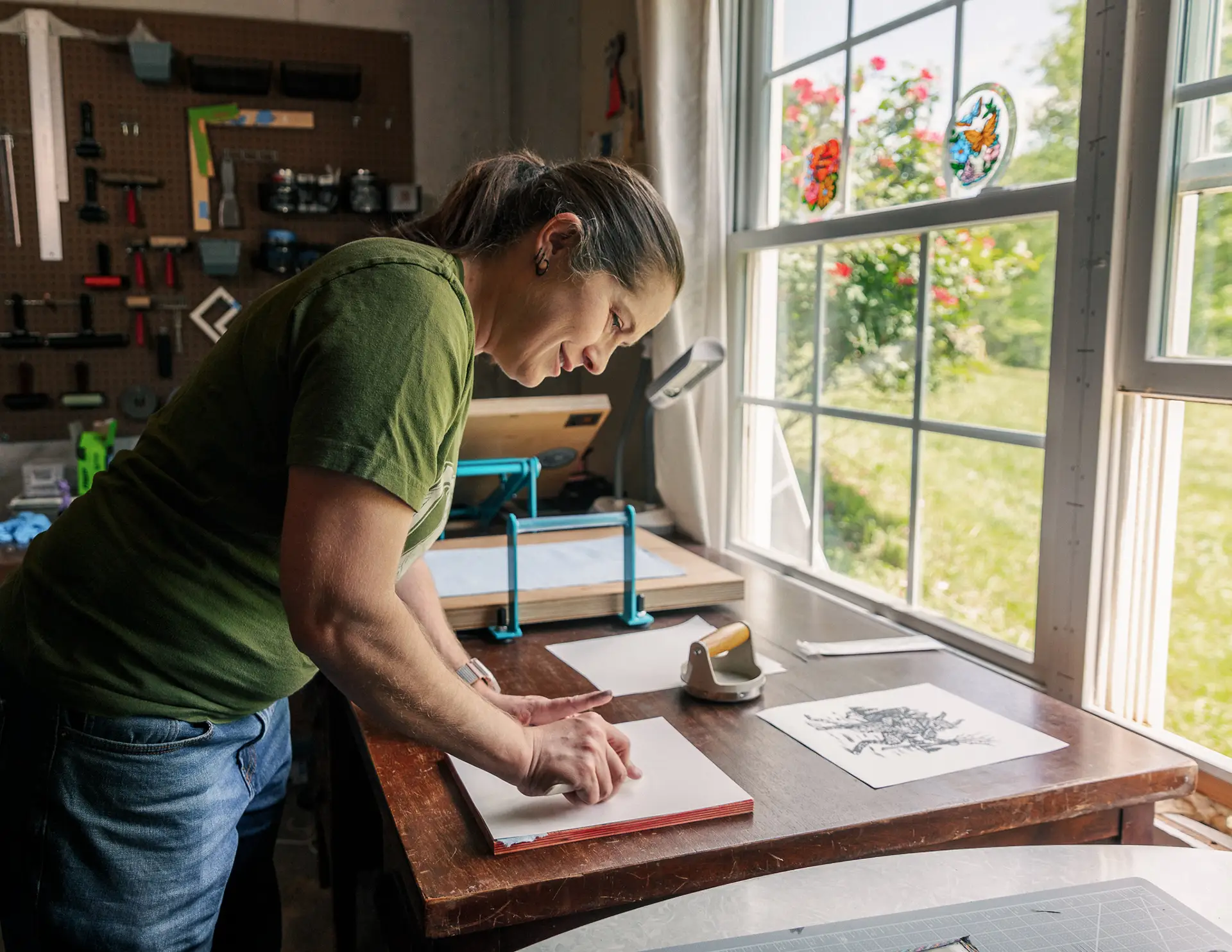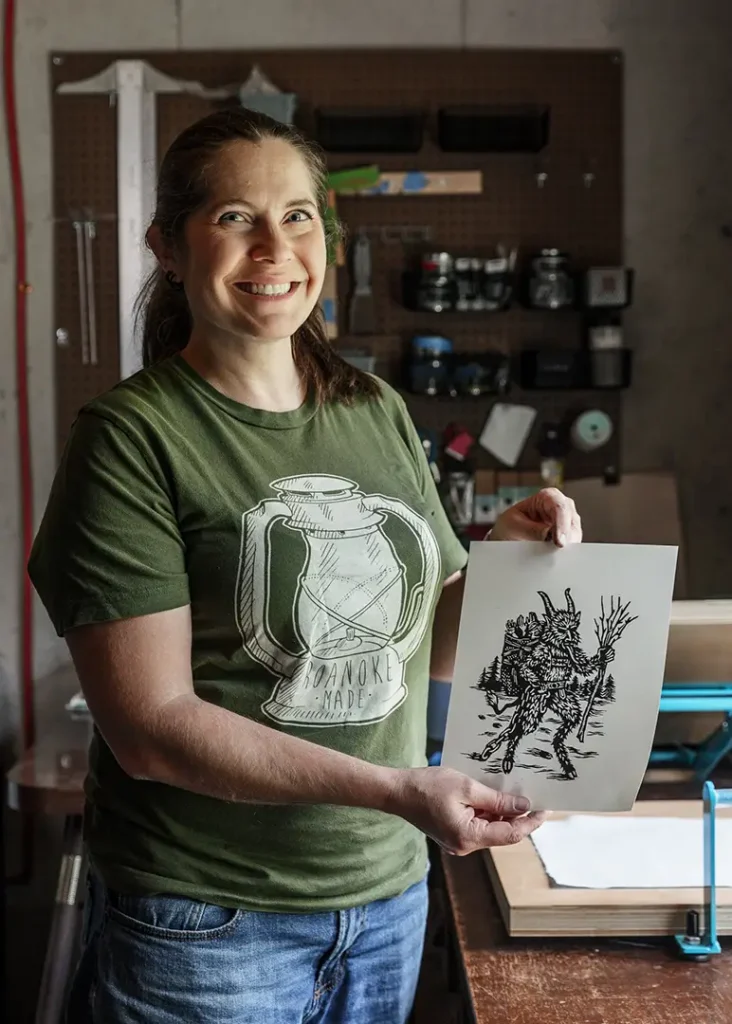
05 Oct Tree Crushed: Dorian Etter’s Journey from Catastrophe to Creation
Sometimes life changes everything in a single moment. For Dorian Etter, that moment came during what should have been a peaceful hike through a Virginia tunnel. When she emerged into daylight, a tree literally crushed her, breaking her neck, her back, and shattering her teeth. She woke up in a hospital with no memory of the impact, facing a long road of recovery from traumatic brain injury and multiple fractures. But from that devastating moment would emerge something beautiful—a deeper commitment to art and the birth of her business, aptly named Tree Crushed.
“I decided to make a business,” Dorian explains of choosing that name over her family’s suggestions of “Art by Dorian” or “Dorian’s Designs.” “My mom was like, is that really what you want? I’m like, yeah. Because for me, that’s kind of what started me to start taking the risks and taking the time for doing art.” The accident became her wake-up call to stop waiting for “someday” and start creating now. “It hit me, there might not be that time. So I need to make time for what’s important for me.”
While recovering in the hospital during COVID restrictions, with limited visitors and the loneliness that comes with extended medical stays, Dorian kept asking her husband to bring art supplies. He hesitated, afraid that her traumatic brain injury might have robbed her of her ability to draw. When magazines her mother brought proved unreadable—the words were there but made no sense—his fears seemed justified. But when she finally got those art supplies, relief flooded through both of them. She could still draw. More than that, creating art became her pathway back to herself.
 Dorian’s artistic journey actually began much earlier, rooted in a childhood where her parents—both artistic themselves though they never pursued art professionally—encouraged creativity over video games or fancy trips. “If we wanted to do something with pets or outside or with art, they’re like okay sure, here’s some art supplies,” she recalls. That foundation carried through college, where she studied biology but found herself illustrating a professor’s research on fish of the Roanoke River, drawing “lots of fish lips and fish bones.”
Dorian’s artistic journey actually began much earlier, rooted in a childhood where her parents—both artistic themselves though they never pursued art professionally—encouraged creativity over video games or fancy trips. “If we wanted to do something with pets or outside or with art, they’re like okay sure, here’s some art supplies,” she recalls. That foundation carried through college, where she studied biology but found herself illustrating a professor’s research on fish of the Roanoke River, drawing “lots of fish lips and fish bones.”
Teaching high school biology became her profession, but art remained her stress relief and creative outlet. Her preferred mediums—pen and ink, and relief printmaking—reflect her need for precision and patience. “I’m a very jittery, anxious person, and you can’t be jittery using a dip pen because you’re going to splatter ink everywhere. So it causes me to slow down.” There’s something almost meditative about the sound of the nib dragging across paper, the careful control required to vary line weights and create intricate details.
Printmaking, particularly woodcut printing, became her passion after taking a class at Arrowmont School of Arts and Crafts in Tennessee. The process appeals to her on multiple levels—the physical satisfaction of carving, the problem-solving when wood doesn’t behave as expected, and the element of surprise when pulling that first print. “It’s almost like yoga how you have to breathe through the poses,” she explains. “When I’m carving, I noticed when I’m pushing I’m exhaling because you’re breathing through the movement.”
Her subjects flow naturally from her deep connection to Southwest Virginia. Growing up without subdivisions or many neighbors, Dorian spent her childhood outdoors with pets and random animals—chickens, rabbits, ferrets, “everything you could think of.” Family trips weren’t to beach resorts but to historic sites along the Blue Ridge Parkway, collecting seeds from special places and sketching in small notebooks. That connection to place runs deep: “When I go to the beach, the beach is great but I feel naked. I feel like I’m gonna fall off the earth because there’s nothing to… how do you just stay in a flat area when there’s no mountains and no trees?”
Her art reflects this intimacy with the landscape and its history. She’s drawn to old buildings with peeling siding, barns weathered by decades of use, mushrooms emerging after rain. These subjects speak to her sense of urgency about preserving what’s disappearing. “It’s not going to be there,” she says simply. “Buildings that are falling around because in the future these buildings aren’t going to be here, or if they are they’re going to be prettied up and renovated.”
This documentation feels essential to Dorian because she’s witnessed how quickly cultural knowledge can fade. When she asks her high school students about traditional foods like bean cakes made from leftover pinto beans, or gravy made from sausage drippings in a cast iron skillet, many don’t know what she’s talking about. “All this older stuff is passing,” she observes. Her art becomes a way of holding onto these disappearing pieces of mountain culture.
Her teaching career enriches her artistic practice in unexpected ways. Drawing biological diagrams on the board for her students, she discovered that teenagers’ fresh perspectives can inspire new ideas. Some of her quietest students turn out to be artists themselves, and bonding over sketchbooks becomes a bridge to reach them. She’s learned to incorporate drawing into her biology lessons, requiring students to illustrate vocabulary terms. “Drawing makes you think about it because now you’re having to think about it visually, which will help you retain it.”
The printmaking process itself reflects Dorian’s scientific background and her comfort with multi-step procedures. Starting with an idea—often inspired by mythology, folklore, or the natural details that catch her eye—she sketches, refines on her iPad, then transfers the design to birch plywood. After sanding the wood smooth, she draws with black Sharpie, covers everything in red Sharpie (in a well-ventilated area, she’s learned), adds shellac, then begins the meditative process of carving away everything she doesn’t want.
“I tell people in workshops, just think about everything you don’t want in your life,” she explains. “Sometimes it’s hard to know what you want to do, but you know what you don’t want.” The metaphor goes deeper than technique—it becomes a way of processing emotions and experiences through the physical act of removal.
The printing itself requires patience and acceptance of imperfection. Oil-based inks must be “woken up” and rolled to the right consistency—something you learn by feel rather than instruction. Paper must be prepared, registration carefully managed, pressure applied by hand or press. For multi-color reduction prints, you might start hoping for 30 good prints and end up with eight usable ones. “It’s kind of a leap of faith,” Dorian says. “But it’s so exciting when you pull off that first print. I really like clap and squeal.”
Her work ranges from detailed nature studies to “Frankenstein tiki monsters,” reflecting her varied interests in everything from mycology to cryptids to old black-and-white movies. This eclecticism worried her initially—shouldn’t an artist have a consistent theme? But she’s learned to trust that authenticity resonates: “If I like it, there’s probably someone else that has awesome taste and will like it also.”
Joining Round the Mountain Arts Network provided the community connection Dorian craved as a largely solitary artist. “Even though you do a lot of stuff on your own, it’s nice to have a community,” she explains. The network offers practical benefits—legitimacy for her business, answers to questions about artist statements and artisan events—but also validation. Having work displayed at the Southwest Virginia Cultural Center means “your work is valid, not to say that other work isn’t valid, but it was selected and to be a part of something that’s not just for you, but kind of curated for the community.”
What Dorian hopes people feel when experiencing her art reflects her deep appreciation for handmade objects in an increasingly digital world. She wants viewers to “appreciate the handmade nature of it and the time that someone has spent,” to notice the “little Easter egg hidden details” and see “the artist’s hand in it.” Most movingly, she hopes her work becomes part of people’s lives and memories, the way her grandparents’ simple fire picture became an enduring symbol of warmth and home.
Her students see this philosophy in action. When they ask if she drew the illustrations in their ecology booklets, the conversation that follows often reveals quiet artistic talents. Some of her most reserved students turn out to be accomplished artists, finding in their shared creativity a way to connect and communicate. Through both her teaching and her art, Dorian demonstrates that making things by hand—whether drawings to explain scientific concepts or prints that capture disappearing barns—offers something irreplaceable in our digitized world.
The name Tree Crushed carries all of this meaning: the accident that could have ended everything, the recovery that revealed what truly mattered, and the slightly dark humor that helps process trauma. “Now I get to use sharp tools and get back at all the trees,” she jokes. “I’m taking a little bit from you and I’m making something pretty out of it.” But the deeper truth is that from destruction came creation, from forced stillness came movement, and from nearly losing everything came a clearer understanding of what deserves to be preserved and shared.
In Dorian’s work, we see how art can serve as both personal healing and cultural memory, how traditional techniques can capture contemporary concerns, and how the act of making something by hand—slowly, carefully, with attention to detail—becomes an act of resistance against a world that increasingly values speed over substance. Her story reminds us that sometimes our greatest challenges become the foundation for our most meaningful work.


